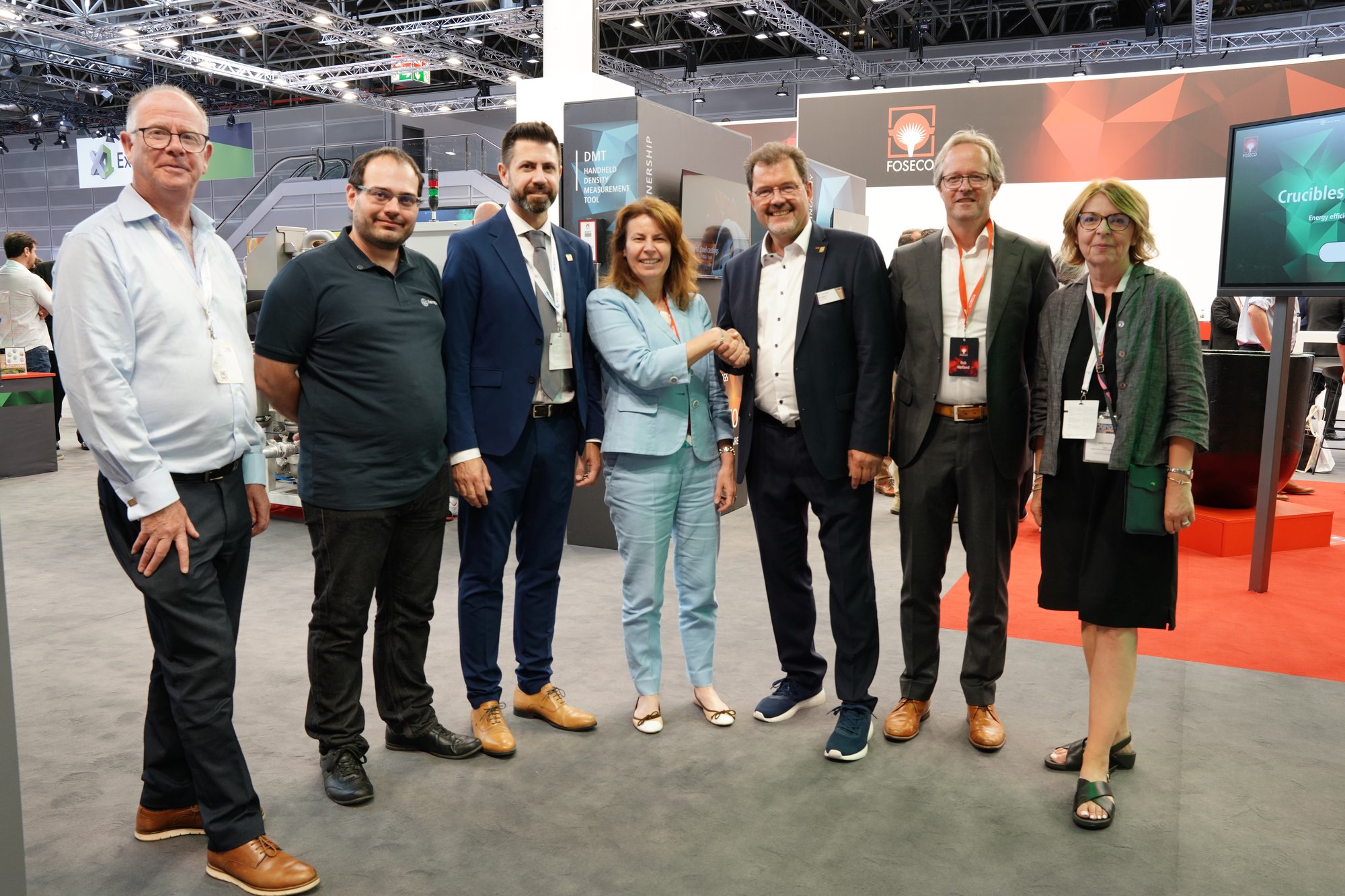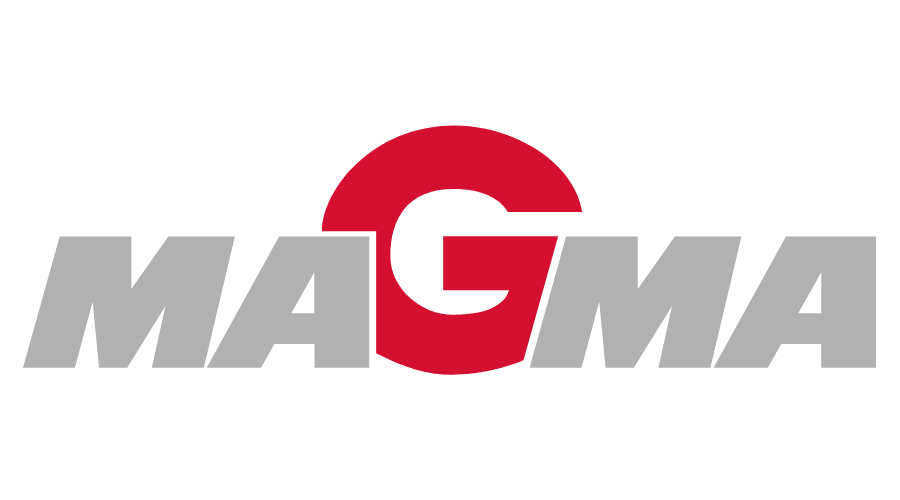Interviews with our partners at GIFA
WFO interview
Networking the future
Interview with José Javier González, General Secretary of the World Foundry Organization (WFO)
MAGMA interview
Partnership past, partnership future
Interview with Dr Marc Schneider, MAGMA CEO and Presidenty.
Networking the future
Interview with José Javier González, General Secretary of the World Foundry Organization (WFO)
The future of the foundry sector is “really positive”, according to José Javier González, General Secretary of the World Foundry Organization (WFO), who was speaking at the Foseco stand at GIFA 2023. Global production is recovering after the declines seen during the COVID-19 pandemic and long-term trends support growth. “Manufacturing will always need castings, so as manufacturing demand rises over time, demand for our industry’s products will follow.”

Foseco and the WFO celebrate the Lifetime Legacy sponsorship agreement at GIFA 2023: Eur. Ing. Andrew Turner - Executive Secretary WFO, Lionel Alves – Executive Member, WFO, José Javier González - General , Secretary WFO, Karena Cancilleri – President Foseco, Dr Carsten Kuhlgatz – President WFO, Rob Welland – Vice President Marketing & Technology Foseco, Lynn Postle - Editor, Foundry Trade Journal.
Costs, skills, and sustainability
That’s not to say there are no storm clouds ahead. The most pressing problem now is “ensuring foundries can be profitable, as cost pressures have been rising across the industry over the last few years, exacerbated by the current energy crisis,” said González. “There is also an acute shortage of workers, which is impacting all regions, with foundries facing a major challenge in recruitment and training.”
And then there is sustainability and the industry’s response to climate change. “Decarbonization of the foundry industry is necessary,” said González. “The issue for us is how we get there. What is the roadmap for making this possible? Foundries around the world are concerned about this and taking steps to reduce emissions. But real change will need us to move together as an industry.”
Connecting the global foundry industry
González believes the WFO has a key role to play in supporting the industry to meet these global challenges. “Our strength is our wide global network. This enables us to identify best practices from around the world and bring them to a wider audience. We can also bring the industry together in a neutral setting to discuss issues and work toward a solution.”
As an example, González noted a recent event hosted by the WFO that brought foundry operators from around the world together in Hannover, Germany, to discuss decarbonization, with the aim of creating an industry roadmap to net zero. “Attendees were keen to attend and co-operate to come up with a solution,” he added.
It is this ability to bring together the industry from around the world that also makes GIFA such as important event for the foundry sector, continued González. “GIFA is a vital meeting place: the place you need to be to network and connect with the latest solutions and innovations in the industry. That’s the great value of GIFA.”
Working together, toward a better future
Partnership and knowledge were a key theme of the Foseco stand at the tradeshow. The stand featured 37 customer case studies, showcasing how the company works with its customers to develop new productions and solutions. “We don’t believe that anyone has all of the answers,” said Foseco’s Vice President for Marketing and Technology, Rob Welland. “The industry will therefore only find the solutions it needs by building strong partnerships.”
Foseco also announced it was becoming a Lifetime Legacy Sponsor of the WFO at GIFA. “We are excited about this new agreement, which further strengthens a relationship that has been growing for some time and will enable us to propose and develop a greater value proposition for our industry,” said González.
“We are committed to the ongoing success of the foundry industry and believe the WFO has an important role to play in delivering this,” added Foseco’s Rob Welland. “For this reason, we’ve long sponsored the WFO and many events that they organise. At a key moment for the industry, it was a natural next step for us to take our involvement to the next level, to further engage with and support the industry as it works to recover and flourish in today’s sometimes-difficult market conditions.”
Partnership past, partnership future
Interview with Dr Marc Schneider, MAGMA CEO and President
GIFA is a tradeshow that brings the foundry world together. Thousands attend to make new connections and renew old acquaintances. But for two old friends in particular, this year’s event held special relevance, marking the 20th anniversary of their strategic alliance.
Foseco, a global supplier of casting consumables, and MAGMA, a leader in casting process simulation and virtual optimisation, officially joined forces to support their mutual customers in 2003. But as MAGMA CEO and President, Dr Marc Schneider explained in an interview at the Foseco stand at GIFA 2023, the relationship goes back about a decade before that.
Building a successful, decades-long relationship
“Foseco has been using MAGMASOFT®, our casting simulation program, for almost 30 years,” said Dr Schneider. “But in the early 2000s, we started to talk about intensifying that relationship. At that time, Foseco were looking for a tool that could be used by its application teams to visualize and characterise the performance of its products to its foundry customers, especially on the feeding and filtration side. For our part, it was an opportunity to dramatically increase exposure and highlight the uses and benefits of simulation software to much wider audience.”
The strategic alliance was sealed in 2003. Under the agreement, MAGMA developed a special version of MAGMASOFT – MAGMASOFT Express – for Foseco engineers, allowing quick and efficient set-up of simulations, even in the field. The companies also jointly developed the first Foseco Pro module for MAGMASOFT. Comprising a database of the main Foseco feeding and filtration products, with 3D geometries and their performance in casting, Foseco Pro was the first available solution to describe the performance of foundry consumables based on first principles. It allows the user to quantitatively consider Foseco products in their simulation analyses.
“These products have continued to evolve over time as a result of many technical discussions between ourselves and Foseco,” continued Dr Schneider. “For example, we continually add functionality and new Foseco product developments into FOSECO Pro. The latest release includes Foseco’s shroud technology, as well as allowing recommended filter prints to be integrated into MAGMASOFT®. This has helped both our own ongoing development of the MAGMASOFT® software, but also aided product development on the Foseco side, for feeding systems, filters, and other applications of the company’s products.”
Benefits beyond the alliance
Both sides have thus benefitted over the last twenty years. “It’s been truly a two-way relationship. That was the idea when we started and, from my point of view, that has come to fruition,” said Dr Schneider. But the benefits are also felt far beyond the two alliance partners.
“Our simulation software gives foundries a common language with Foseco to discuss the application and performance of Foseco products within their specific foundry environment,” Dr Schneider explained. “It therefore facilitates dialogue and enables the collaborative development of solutions. It also allows foundries to efficiently characterise the performance of Foseco products when laying out castings in their engineering department. From this point of view, hopefully we have allowed our common customers to apply Foseco technology to the best extent possible in optimising quality and minimising resource consumption.”
The alliance has also helped to demonstrate more widely through the industry the value of simulation as an effective tool for improving day-to-day foundry practice. “Over the last twenty years, we have seen casting process simulation and virtual optimisation become increasingly accepted by and integrated into foundry applications, as its usefulness has both been proven and expanded alongside advances in the technology,” said Dr Schneider. “It is now an important part of many modern foundry operations, and I don’t think that will change in the future in light of the increasingly complex challenges faced by foundries today.”
A model for the future
Looking back at twenty years of partnership – and with the bustle of the GIFA crowd around – Dr Schneider also reflected on the importance of collaboration for solving those complex challenges.
“I’m sure the industry won’t get by without strong partnerships,” the MAGMA CEO concluded. “I think that has always been the case, but it will be even more so in the future. In that respect, the Foseco-MAGMA alliance can be regarded as a kind of “role model.” We have to use our own individual competencies and synergise them with others to come up with new products, new ideas, and new technologies, which allow the industry and its individual participants to succeed. I’m convinced that’s the only way forward.”

